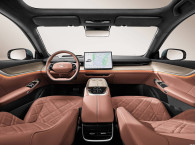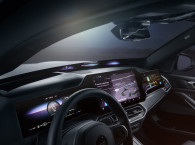This article examines noise sources in automobiles and the various noise cancellation technologies to better understand the future of sound management in car audio systems.
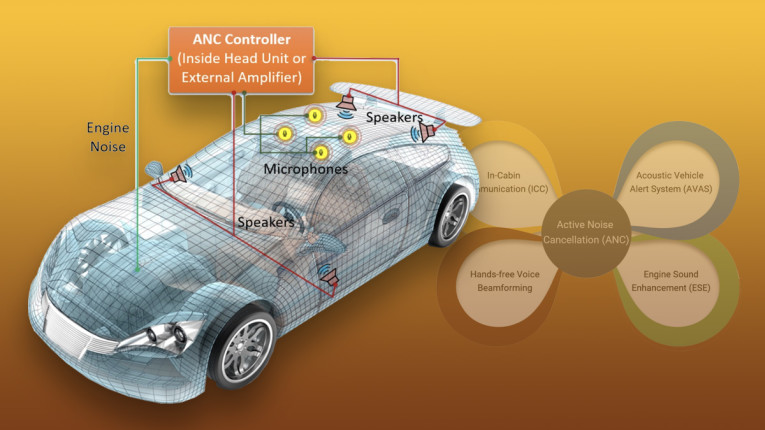
The automotive industry has widely acknowledged vehicle electrification as an effective way to improve fuel efficiency and reduce its carbon footprint. While it is true that Hybrid Electric Vehicles (HEVs) use a combination of the traditional Internal Combustion Engine (ICE) and one or more electric motors for propulsion, Electric Vehicles (EVs) exclusively use electric motors. With significantly different acoustic environments inside their cabin interiors, car manufacturers have a strong drive to innovate in noise cancellation and other car audio technologies. Let us examine noise sources in automobiles and talk about the various noise cancellation technologies to better understand the future of sound management in car audio systems.
Understanding Noise Sources in Automobiles
The passengers inside the cabin are subjected to several external noise sources such as road-tire noise and wind noise and several internal noise sources such as engine noise, HVAC noise, exhaust noise, vibration noise, etc. The relative contribution of these noise sources to the total noise depends on several factors, such as the vehicle’s speed and acceleration conditions, the quality of roads and tires, the order and stroke of the engine, and the vehicle’s aerodynamics, among others (Figure 1).
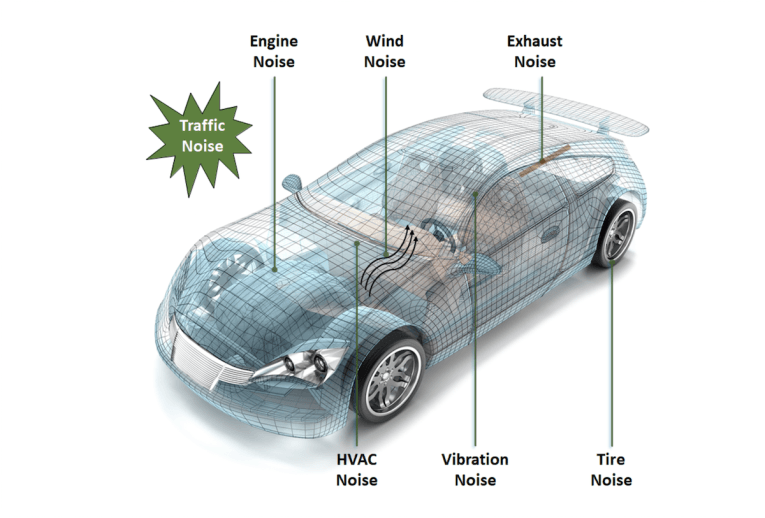
The engine noise in a typical ICE is dominated by the piston crank mechanism and combustion noise. Engine noise is observed at all speeds and depending on the type and stroke of the engine, revolutions per minute (RPM), acceleration-deacceleration conditions, etc., the noise profile will differ. Road-tire noise is generated by the interaction between the road surface and tire and is dependent on the tire tread pattern and physical profile of the road surface. The road-tire noise is pre-dominant at mid-speeds, between 30mph to 60mph.
The wind noise is induced by the aerodynamics of the vehicle that generates turbulence and aerodynamic drag. The wind noise becomes a primary contributor at higher speeds, typically over 60mph. As a combination of all noise sources, the total noise spectrum can be represented, as shown in Figure 2. These noise sources have most of the acoustic energy concentrated within the frequency band of 20Hz to 1000kHz.
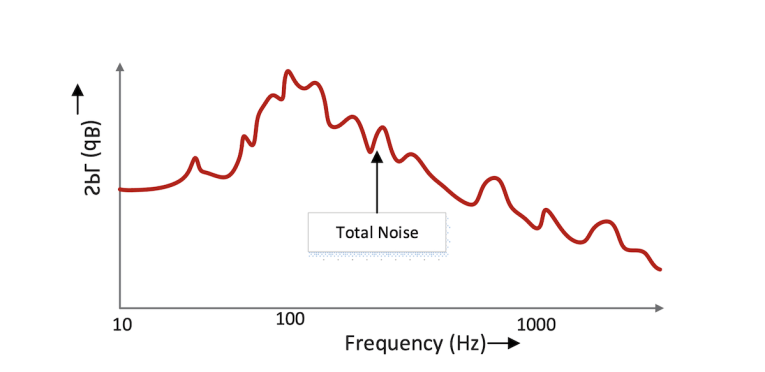
In HEVs, the engine’s noise contribution to total noise is relatively small compared to traditional IEC vehicles. In EVs, the traditional engine noise does not exist. The high-frequency noise from electric motors in EVs have relatively much lower acoustic energy and can be even further attenuated by careful design of transmission loss and acoustic absorption techniques. However, the significant reduction in engine noise in HEV/EV is a double-edged sword (i.e., the noise from the other noise sources become easily perceivable to human ears).
With a conservative estimate of 6dB background noise reduction because of the absence of ICE in EVs, the other noise sources stand out and can get annoying to human ears. Also, as HEV/EVs have lower background noise, the car manufacturers get a perfect opportunity to provide an even better acoustic experience inside the car by improving their other audio systems without adding significant cost.
Introduction to Passive Noise Cancellation (PNC)
Passive noise cancellation (PNC) uses noise-isolating materials to absorb and dampen the acoustic energy of the undesired sound wave (Figure 3). In this approach, structural dampening materials such as fiberglass and cell foams are sandwiched in-between car body parts. Special laminated windshield and window glasses, door sound barriers and seals, special dash, floor, roof mats, and carefully designed muffler systems—all dampen the sound waves before they reach inside the cabin.
Introduction to Active Noise Cancellation (ANC)
Active Noise Cancellation (ANC) is a relatively newer approach to reduce background noise inside cabin interiors. As shown in Figure 4, an ANC system produces an “anti-noise” signal that destructively interferes with the original noise to remove the background noise.
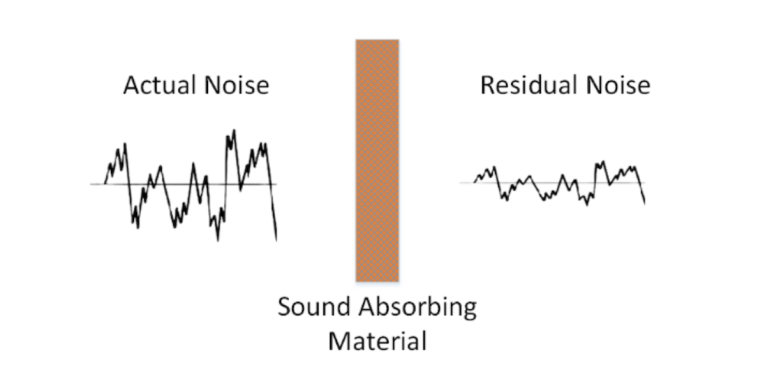

The ANC system needs external power and uses several transducers (microphones and loudspeakers) and semiconductor components. With modern infotainment systems with built-in loudspeakers for playing audio, the ANC system leverage a significant portion of the available audio system and hence comes at a relatively low-cost adder. As shown in Figure 5, an ANC system works by measuring the constantly changing noise inside the cabin using strategically placed microphones throughout the interior cabin of a vehicle.
These microphones measure the interior cabin noise and send it to an audio subsystem. This audio subsystem processes the measured signals in real-time using advanced Digital Signal Processing (DSP) techniques with adaptive algorithms to provide an anti-noise signal output to the built-in car loudspeakers. These loudspeakers generate an out-of-phase acoustic field that destructively cancels out the original field and removes background noise.
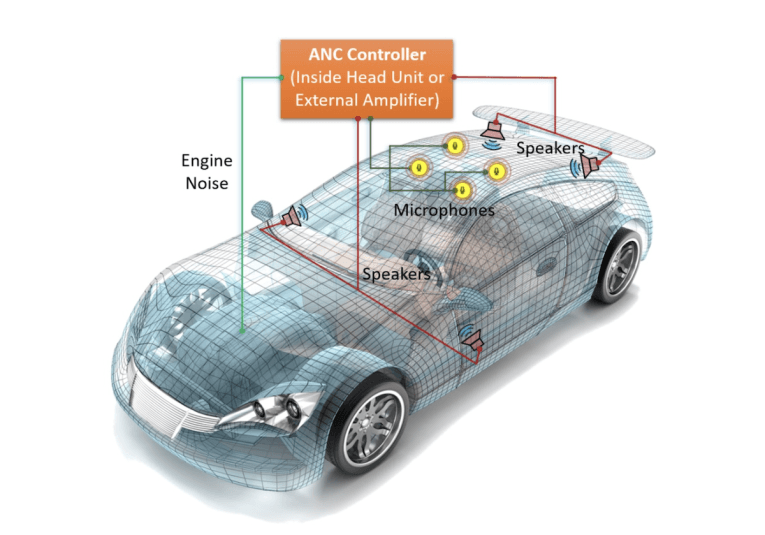
Comparison Between ANC and PNC
ANC is more effective at frequencies less than 1kHz, whereas PNC is more effective at frequencies greater than 800Hz. The effective frequency regions and the noise attenuation achievable by ANC and PNC approach is shown in Figure 6. While PNC is effective for reducing high-frequency noises, ANC is most effective for low-frequency noise reduction. In addition, ANC offers better background noise reduction compared to the PNC method at low frequencies.
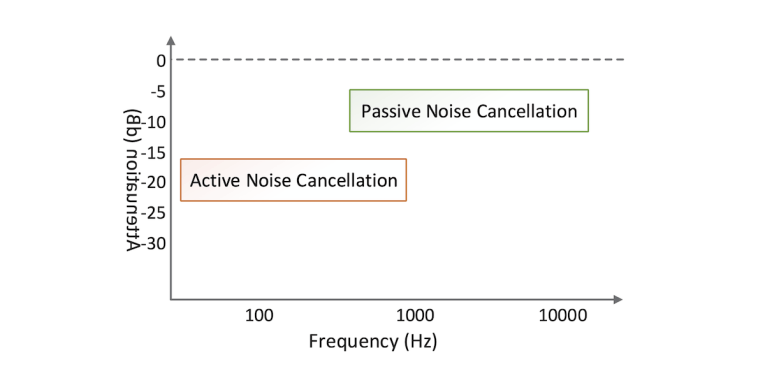
Noise sources such as wind noise, engine noise, and HVAC noise have most of their acoustic energy concentrated at < 1kHz. They emit both tonal and broadband noise. The tonal noise characterized by spectral tones is usually annoying to human ears and induces the most fatigue to passengers. The PNC techniques cannot target specific tones in the spectrum without seriously compromising weight, size, and cost. On the contrary, ANC can offer targeted tonal noise reduction and broadband noise reduction by DSP implementation using adaptive notch filters.
With the advent of HEVs and EVs, as the engine gets less powerful (in the case of HEVs) or is eliminated completely (in the case of EVs), the road and wind noise become even more noticeable. As car manufacturers emphasize lightweight designs to meet ever-increasing fuel economy standards, the ANC method that does not compromise on weight has a very strong value proposition compared to PNC to attenuate the low-frequency tonal and background noise. PNC implementation can get bulky and complex to achieve the same. A typical mid-sized car has more than 100 lbs. of insulating material, and hence any weight reduction using the ANC system is highly appreciated by car manufacturers.
One of the major advantages of PNC is that the sound isolating materials used have multiple purposes (i.e., they not only attenuate high-frequency traffic noise but also help reduce car vibrations and improve thermal insulation). Hence, PNC method works complimentary to the ANC system and cannot be eliminated.
Bass band frequencies typically range from 20Hz to 250Hz, and mid-band frequencies typically range from 250Hz and over. Since ANC are the most effective in these bass-band and mid-band frequencies, a superior audio music playback experience inside the cars with ANC systems can be expected. The key differences between ANC and PNC techniques are shown in Table 1.
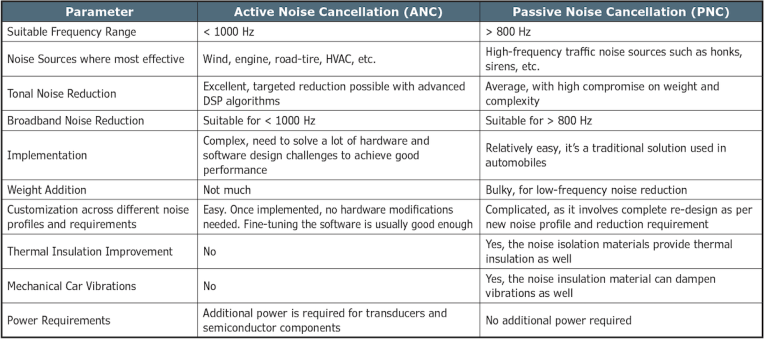
Future of Sound Management in Car Audio Systems
ANC enhances the driving and in-cabin passenger experience to a different level, resulting in reduced fatigue and improved comfort. ANC allows for quieter cabins that enable clear communication among vehicle occupants, referred to as in-cabin communication (ICC), and high-fidelity hands-free voice calling using beamforming technologies. Because of ANC, quieter cabins also drive car manufacturers to offer even better audio music playback experience (e.g., true 3D surround sound).
Engine Sound Enhancement (ESE), especially observed in small fuel-efficient HEV/EV cars, generate artificial vehicle engine and exhaust sounds through the same audio system. These ESE systems in the absence of “powerful” engines enhances certain engine tones typically induced by intake and exhaust systems. ANC and ESE systems work simultaneously to create super-quiet interiors while simultaneously offering a much sportier driving experience.
The different drive selection modes such as Eco, Normal, Sport, etc. in HEV/EVs offer specific acoustic in-cabin signatures using ESE and ANC systems. HEV/EV cars are quieter at low speeds and can pose additional risks to pedestrians and cyclists. Acoustic Vehicle Alerting Systems (AVAS), now slowly becoming a mandatory feature worldwide, is designed to create artificial sounds to alert pedestrians on the road.
Silicon Labs Si479xx automotive radio receivers integrate an audio subsystem with audio DSP, analog-to-digital converters (ADCs), and digital-to-analog converters (DACs). In addition, Silicon Labs provides a software development kit (SDK) that simplifies porting of audio algorithms to the audio subsystem. This high-level of integration offers a greater flexibility to automotive radio suppliers to port audio algorithms for ANC, ESE and other audio post-processing applications.
Additional product portfolio information is available here. As vehicle electrification and ANC trends pick momentum, there will be increased adoption of advanced sound and audio technologies in IVI systems. Figure 7 shows some of the potential future sound management ecosystem that could be available. aX

 About the Author
About the AuthorKrunal Maniar is the Senior Product Marketing Manager for Broadcast Automotive Products at Silicon Labs, a business unit subsequently sold to Skyworks. Krunal brings over 10 years of multi-disciplinary automotive engineering and business expertise, spanning marketing, product definition, and validation at leading technology companies. He earned his Master’s in Electrical engineering from Arizona State University.




